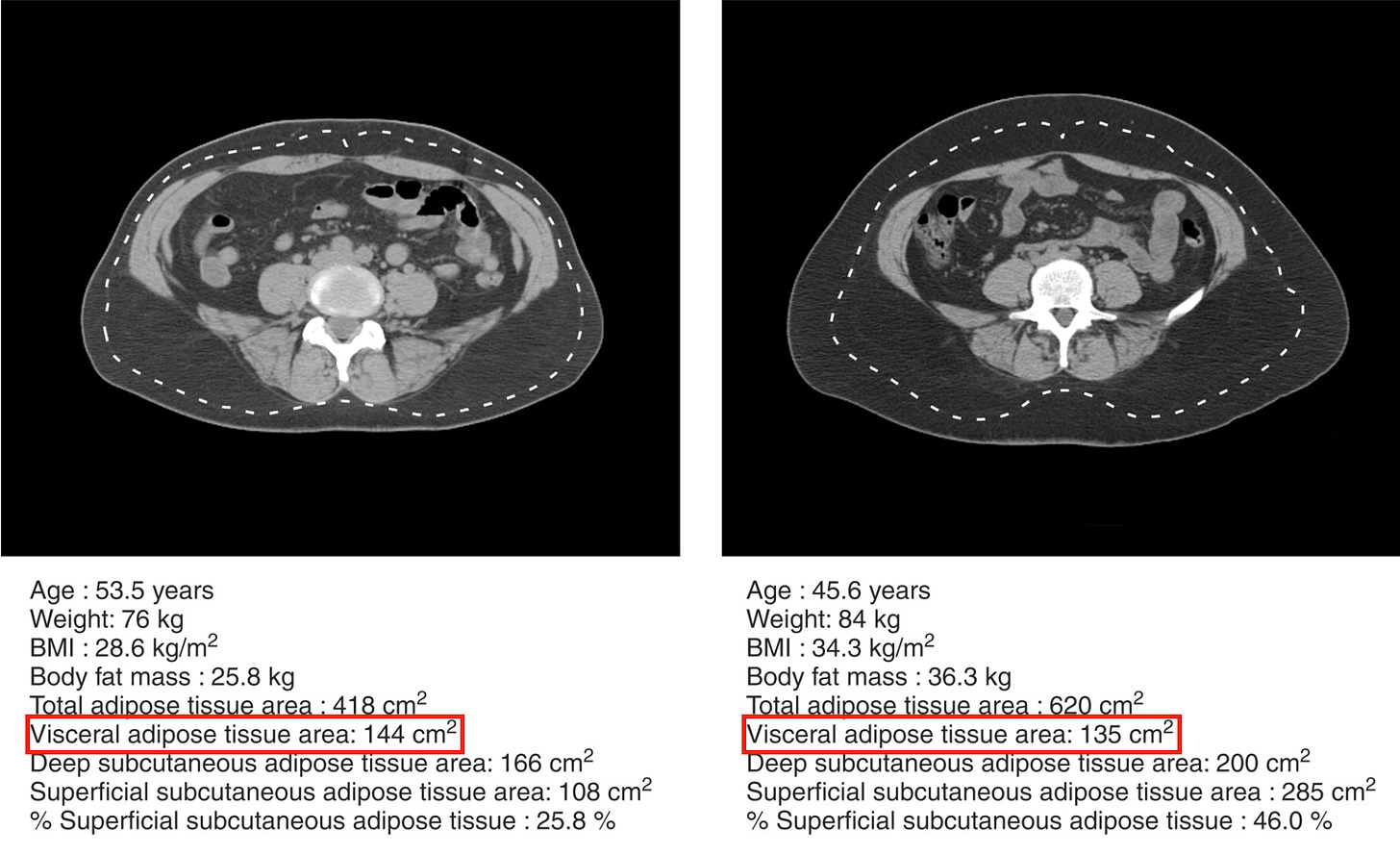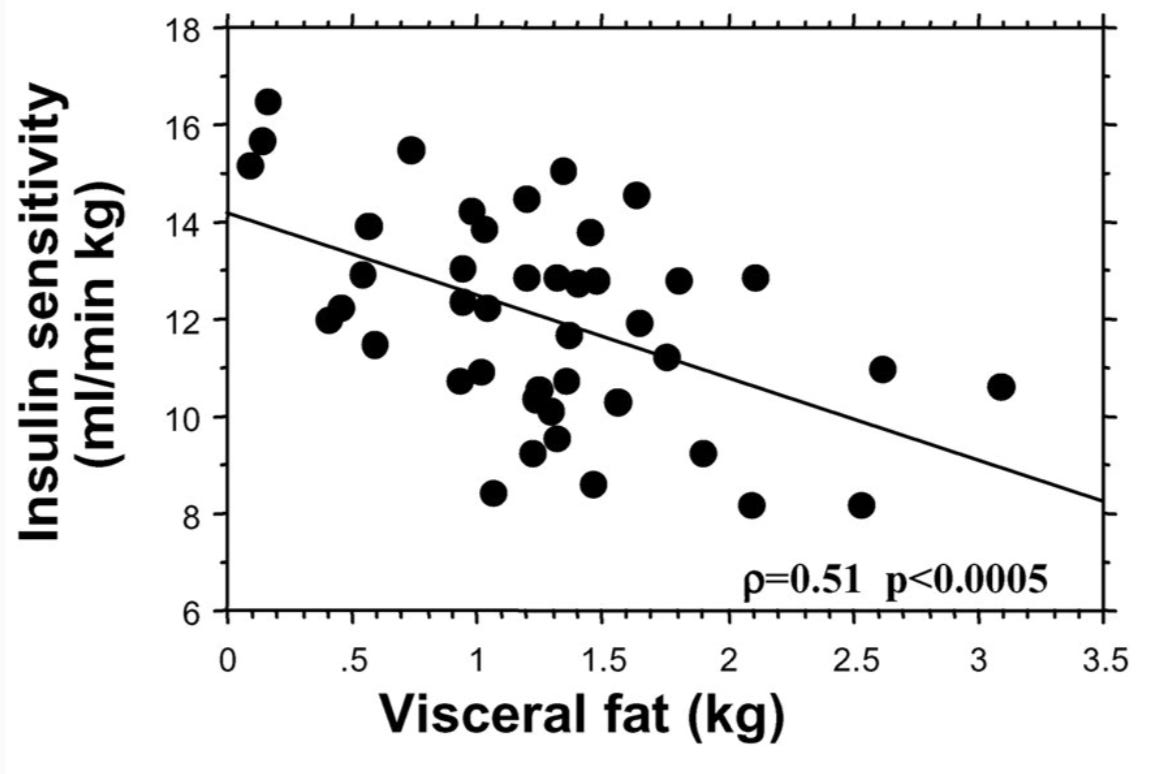Not All Fat Is Created Equal

Greater amounts of fat are associated with a higher likelihood of an earlier death1.
This should come as no surprise.
However, not all fat is created equal, and not all of it comes with the same magnitude of risk.
We have all seen the case of the individual with a very high BMI and significant amounts of fat (Adipose Tissue) who has no evidence of heart disease, diabetes or cholesterol elevations.
A term used for this group is ‘Metabolically Healthy Obese’.
Why is this the case?
The answer likely lies in ‘where’ fat is stored rather than solely ‘how much’ a person has.
In general, there are two types of fat:
-
Subcutaneous Fat
-
Visceral Fat
Subcutaneous fat is the fat stored just beneath your skin. It’s the fat you can pinch on your belly or side. It’s the fat most people are attempting to lose when trying to lose weight. This fat, however, is largely metabolically inert and leads to minimal biochemical inflammatory or metabolic changes2.
Visceral fat (VAT or Visceral Adipose Tissue) is the fat that is mainly stored in your abdominal cavity, including your liver and pancreas. You cannot pinch this fat, but at high levels, you will notice it primarily as an increase in your waist circumference. Can’t fit into the jeans you wore on your 21st birthday? That’s likely the result of visceral fat accumulation. Visceral fat is very metabolically active and is likely the primary driver of risk associated with obesity.
Visceral fat is the fat you want to avoid.
‘Metabolically Healthy Obese’ have substantial amounts of subcutaneous fat and limited amounts of visceral fat. They may not like the way they look, but they are at a reduced, but not zero, risk of metabolic complications.
Take these two individuals below.
The one on the right has a higher weight, higher BMI and greater fat mass but has LESS visceral adipose tissue than the person on the left, who is of lower weight, has lower BMI and has less total fat mass but HIGHER visceral adipose tissue.
The person on the left (Higher VAT Mass) is at a higher risk of metabolic complications yet would appear to be healthier at first glance.

Adipose Tissue Overflow Hypothesis
One theory why some individuals accumulate more visceral fat quicker than others is that our subcutaneous fat stores have a set threshold where if exceeded, most excess fat accumulation is shunted to the visceral fat stores.
Some people will have very large subcutaneous stores (Metabolically Healthy Obese), while others will have very small stores and accumulate visceral fat very quickly.
This latter group are often termed TOFI’s; Thin on the Outside and Fat on the Inside.
Those of South Asian heritage are more likely to deposit visceral fat at a lower total weight which is likely driving the huge increases in metabolic dysfunction, such as diabetes and heart disease, in this population in those at relatively normal weight3.
“I don’t really care what weight you are.”
When patients ask me what weight they should be, I usually don’t have a set number.
My target weight for them is the weight that results in the lowest amount of visceral fat and, by extension, minimises their metabolic risk in terms of their insulin levels, cholesterol levels, blood sugars, amount of liver fat etc.
My rough target for most people is to fit into the jeans they wore when they were 21.
Most people laugh when I say this.
I don’t.
That is not to say that it is easy or straightforward forward, but if your objective is to minimise as much as possible your risk of early heart disease, certain cancers or dementia, this should at least be a directional target.
So although I don’t really care what weight a person is, I care A LOT about any excess fat causing metabolic dysfunction.
That I want to eliminate.
Assessing Visceral Fat
There are two ways you can assess visceral fat, directly or indirectly.
The indirect approach assesses any of the metabolic abnormalities we have already mentioned and typically means looking at fasting blood tests etc.
In this case, we are looking at the consequences of excess visceral fat. If the consequences are there, the excess visceral fat is likely there.
There are multiple ways of directly assessing visceral fat.
The easiest is to measure waist circumference. This measure captures excess fat in the abdominal cavity, which is likely to be visceral fat. This is also why waist circumference is used as part of the diagnostic criteria for metabolic syndrome.
Waist circumference is not your jean size but the circumference around your abdomen at the level of your belly button.
An increased waist circumference is:
-
Males: >102cm/40 inches
-
Females: >88cm/35 inches
There are more precise ways to assess the likelihood of excess visceral fat using validated VAT calculators, which include age, sex, waist and thigh circumference.
The gold standard for assessing visceral fat mass/area is MRI or CT, but the most commonly used high-quality approach is a DEXA scan.
An important point to note is that not all DEXA scans will provide a VAT mass assessment as this requires additional software analysis on top of the baseline DEXA scan that is done.
So if you are looking at your DEXA report and can’t see a VAT mass result, this is why. Make sure to ask before your test if VAT mass is reported.
The relationship between increasing VAT mass and worsening insulin sensitivity is clear.
Higher VAT = More Insulin Resistance4.

As we have discussed at length previously, insulin resistance is a key driver of all the major chronic diseases that are likely to result in one’s early death.
To reduce the chances of an early death, we need to minimise insulin resistance and, by extension, reduce visceral fat. This is why maintaining a normal weight is associated with so many health benefits.
Reducing Visceral Adipose Tissue
There is no way to target visceral fat exclusively, although some trials have demonstrated differential effects of specific exercise and dietary regimes5.
To begin with, weight loss, in general, is the best approach. Things can be refined at a later point as needed.
This is about using all available tools to achieve sustainable long-term weight loss. As a consequence of that weight loss, visceral fat will be lost, and your metabolic health will improve.
With even modest degrees of weight loss, metabolic parameters improve, and with more substantial weight loss, even diabetes can be reversed in almost 50% of patients6.
Some people looking to lose weight will use options such as liposuction. While their total body weight will decrease significantly, the issue with liposuction is that it only removes subcutaneous fat and not visceral fat.
When you assess those who have had liposuction and substantial weight loss, there is no improvement in the metabolic health parameters we typically measure7.
The evidence is clear.
The risks associated with increased weight result from excess visceral fat and have far less to do with excess subcutaneous fat.
Not all fat is created equal.
It’s time to get out the jeans from your 21st birthday party and try them on.
General and abdominal adiposity and risk of death in Europe. N Engl J Med. 2008 Nov 13;359(20):2105-20.
Why might South Asians be so susceptible to central obesity and its atherogenic consequences? The adipose tissue overflow hypothesis. Int J Epidemiol. 2007 Feb;36(1):220-5.
Why might South Asians be so susceptible to central obesity and its atherogenic consequences? The adipose tissue overflow hypothesis, International Journal of Epidemiology, Volume 36, Issue 1, February 2007, Pages 220–225,
Visceral fat in hypertension: influence on insulin resistance and beta-cell function. Hypertension. 2004 Aug;44(2):127-33.
Dose–response effects of exercise and caloric restriction on visceral adiposity in overweight and obese adults: a systematic review and meta-analysis of randomised controlled trials
British Journal of Sports Medicine Published Online First: 20 January 2023.
Primary care-led weight management for remission of type 2 diabetes (DiRECT): an open-label, cluster-randomised trial. Lancet. 2018 Feb 10;391(10120):541-551.
Absence of an effect of liposuction on insulin action and risk factors for coronary heart disease. N Engl J Med. 2004 Jun 17;350(25):2549-57.




